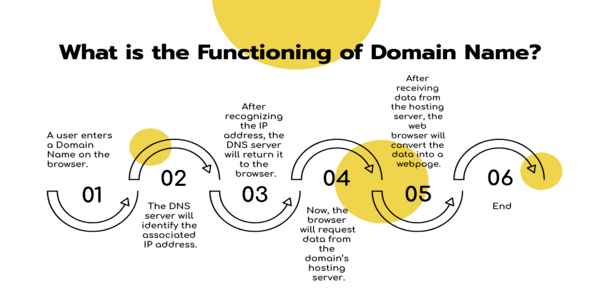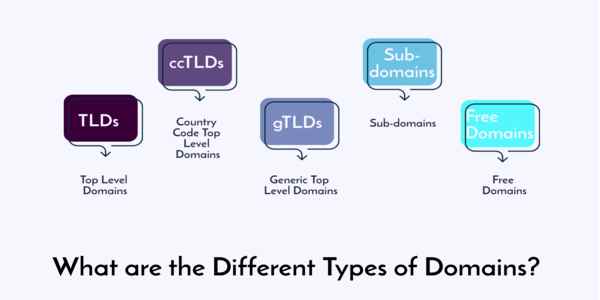To know What is a Domain Name? Imagine you have invited some guests to your house. What is the most important thing they should have for finding your home? Yes, it’s the address. Without the proper address, no one can reach their designated destination effectively on time.
A physical address that helps you reach your destination is like a domain name. That enables you to land on a specific website. A domain name is the equivalent of a physical address in the virtual world.
Usually, an IP address has similarities to a physical address. But an IP Address consists of complex and multiple Numerics. And that is difficult to remember. Hence, an alternative to the IP address was necessary for easy accessibility. That is how the domain name came into existence. Domain name maps a user to the IP address of the desired and make a good website, making it easily accessible.
The Domain name, in technical terms, is defined as a string. That identifies the realm of administrative autonomy, authority, or control within the internet. The establishment of domain names for a particular website and blog. And follows a particular and specific hierarchy in the Domain Name System (DNS).
Table of contents
What is a Domain Name System (DNS)?
It is the largest operational name service on the internet. It serves a diverse community of hosts and users. And networks using unique combinations like hierarchies, caching, and datagram access. And it is a method through which a domain name is established. It follows a hierarchy in the naming system that helps to identify websites over the internet easily. Domain name systems continue to be a vital part of the functioning of the internet.
Domain Name System is a phonebook for the internet as it translates computer hostnames into IP addresses. It forms the core of cloud-based services and content delivery networks. It is used to assign proximal servers to the users. This helps provide reliable and quick services over the Internet. And this is the most widely used internet service.
DNS is equivalent to the administrative body of any organization. It reflects the structure of administrative responsibility for the internet. Every subdomain is marked as a zone of administrative autonomy delegated to a manager. The information is usually complemented by the registry’s RDAP and WHOIS.
The structure of DNS includes –
- Domain Name Space.
- Domain Name Syntax.
- Name Servers.
The development of a Domain Name System involves Applied Computing. Includes computers in other domains, Cross Computing Tools, and Techniques. Like measurement, metrics, performance, and Networks.
What are the Benefits of Domain Name?
A domain name is the most important part of an URL. A well-thought, customized domain can bring you greater advantages than expected. Some of the benefits of using domain names are:
Recognizability
A customer or user coming to your website will not make an effort to remember your web IP address. Hence a well-customized domain name can help you attract them to your website.
A quirky or creative domain name allows your users to remember your website without effort. Gauging the amount of competition today, this is a great method to bring your customers back.
Online Branding
It is very hard to imagine a world without domain names because in that case. Users have to remember IP addresses which is difficult and boring.
Since domain names are customizable. You have the freedom to choose your domain name in sync with your business name. It helps to grow your online business and establish your brand online. A business becomes a brand when its name is easily on the mind of its users.
Customized Email Address
A domain name allows you to create customized email addresses. The email addresses will be unique, professional. And completely in sync with your business.
It helps to achieve uniformity in your presentation among various online platforms.
Enhances Credibility
A customized domain name usually represents a business or a company. If you successfully establish an effective domain name in sync with your business. Your credibility is visible to the users without much effort.
Search Engine Optimization
Search engine optimization is the key to growing online these days. It is the process of incorporating keywords that help optimize the search engine. So that you can improve website ranking at the top of search engine results pages of Google searches.
If your domain name has a specific keyword. You are indirectly optimizing your website only through your URL. As a result, the reach and visibility increase drastically. And it will help your business to be upscale and generate enormous revenue.
What is the Functioning of Domain Name?
Every domain name is linked to their respective IP addresses. And designated to the specific web servers that host them. Every website has 2 components- A Domain Name and A Web Hosting Server. A web server usually stores all the website data, including files, databases, and HTML code.
The functioning of a domain name is explained with the following steps:

It sounds very interesting to know the process behind instant responses from the browser. However, the most exciting fact is that a minute part of a website’s URL. The domain names, plays a significant role in making your website reach the user.
What are the Different Types of Domains?
The domain names are categorized into multiple types. The different variations in the domain names reveal a lot about a particular website; the types are:

Top Level Domains (TLDs)
- As the name suggests, these are the top-level domains available.
- Over 54% of websites use these domain names.
- The most common TLD is .com; it is also a known fact.
- The TLDs are the domains that attract the highest organic traffic. Because of their popularity as users use them by default.
- The Internet Assigned Numbers Authority (IANA) has the official list of legitimate TLDs.
It is among the most expensive domain names to purchase. But it benefits from quickly skyrocketing your business or company’s website.
Country Code Top Level Domains ( ccTLDs)
- It is a top-level domain name specific to a particular country. It has an additional 2 letters that represent international country codes.
- Some companies are specific to a particular country; for such companies, ccTLDs are very useful.
- Companies with global dreams should not use ccTLDs as it may limit their growth and accessibility to a specific country.
- The Governments of respective countries mostly use the ccTLD domain names for their websites. It is marked as representing their country and a matter of pride.
- The World Intellectual Property (WIPO) has a database. And that assists in finding the country codes of all the countries existing in this world.
Generic Top Level Domains (gTLDs)
- It is a type of domain name that specific agencies and organizations sponsor. There are no specific criteria to register for a gTLD.
- A few generic TLDs are reserved for specific types of registrants. It is a category-specific domain. Hence it requires your company to belong to a particular category.
- Some examples of gTLDs are:
- .edu– Specific to Academic Institutions
- .gov– Specific to Government Agencies, etc
Second Level Domains
- It is a section of a domain name present to the left of a top-level domain name.
- For example, canva.com, in this domain name .com, is a TLD, and canva is an SLD.
- It is used to make registries that indicate a specific entity registering.
Sub-domains
- It is a division of the parent domain that shares the same servers. For example, the most commonly used sub-domain is www (World Wide Web).
- It does not need a separate registration.
- Creating sub-domains aims to divide and organize the web address into separate sections.
- It also comes in handy when creating another website with the same name but in a different language. Wikipedia uses en as a sub-domain for the English language. And es as a sub-domain for the Spanish Language.
Free Domains
- The free domains are most popular among beginners starting their content creation journey on the internet.
- Websites like WordPress, Bloggers.com. And other content management sites allow users to create their websites free of cost.
- The above websites provide the best blogging platform for beginners to learn. And develop their skills before investing in them.
- The free web address follows a structure similar to sub-domains. Like organicworld.wordpress.com or organicworld.blogspot.com.
Since it is a free domain names. It is very difficult to bring traffic to these websites. Hence, after your practice session is over. Choosing among the available paid TLDs is always advised.
Conclusion
“The most beautiful things come in small packets”- a very beautiful saying that thoroughly complements the domain name. It is such a small part of a website, yet it helps make your website unique, professional, and profitable. Domain names are a great source of marketing strategy in your online business.
Name of domains plays such an integral part in giving meaning to a website. Customization is key to being recognized, visible, and reachable for online businesses. Unless you create a workable pathway for your customers to reach you. Running your business will become extremely difficult.
Entrepreneurs always focus on refining their products. But the products can only give your business when it is visible to your customers. An enticing domain name can help you attract customers and make your reach larger. Hence, diversify your efforts when you run a business. In addition, indulge in creating exciting domain names suitable for your business. Preferably the ones satisfying search engine optimization (SEO) preferences.
Related Topics
- .Com vs .Net
- How to Start Blogging on WordPress
- Secure Socket Layer (SSL)
- Best Website Builder
- What is slug? (URL)
- Godaddy Alternatives
- Managed WordPress Hosting
- Chemicloud vs. Siteground
- SiteGround vs. Liquid Web
- Siteground Alternatives
- Blog Name Generator
- Blog vs. vlog
- WordPress.org vs WordPress.com
- WordPress vs. Blogger
- What is the Cost of Developing a WordPress Website?
